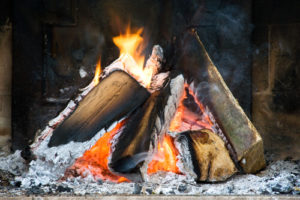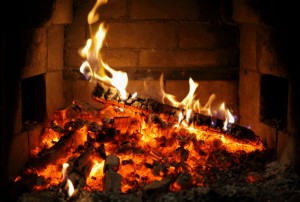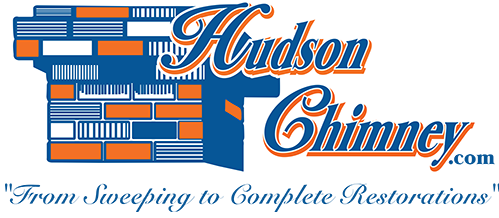by Mark Hudson | Feb 6, 2018 | Ash Disposal
Every day that you burn wood in your fireplace, you are creating ash. Over the course of an entire winter, you may have to remove ashes from your fireplace countless times. It’s a headache, but it’s necessary. Leaving them in the firebox can crowd your fire, make it difficult to light and maintain, and even cause wood and hot ashes to fall out of the fire! Don’t risk it, remove the ashes regularly, and remove them safely.
Use Appropriate Tools
You can find fireplace accessories at a home improvement store. Make sure they work for you, because not everyone is the same. Be sure the shovel is long enough that your face and hands are away from the hot fire. Homeowners who have asthma or chronic respiratory illnesses may choose to wear a face mask while cleaning ashes from the fireplace. Make sure that your clothes are not loose and that hair does not drop close to the fire. It is best to remove ashes when the fire is out or very low. Removing red hot coals is dangerous, even if you have an appropriate metal bucket to store ashes in. Scoop the ashes into your metal bucket, and carry them outside to cool at least 5 feet from your house. If you save ashes for various uses, you may have a metal trashcan with a lid to dump them into. Keep this container away from flammables.
Reasons to Save Your Ashes
Your ashes are going to continue to build up throughout burning season, with you removing them regularly. Leave ¼ inch each time in order to insulate the bottom of the firebox. The rest can be useful for many purposes.
Cleaners: Add water to a small amount of ashes and polish silver, doorknobs, and chrome. Larger amounts mixed with water can clean stoves, ovens, and pots and pans.
Deodorizer: Dust a handful of cool, dry ashes into your pet’s fur to neutralize odors and deter mites and ticks.
For the Garage: Toss ashes onto slick sidewalks and driveways to prevent slips and falls. Pour onto oil spills on the driveway and in the garage.
For the Garden: Sprinkle ashes over soil to change the alkaline levels for certain plants to thrive. Putting along the edge and in between rows also deter bugs and slugs.
Get Creative: You can use your ashes to make lye, which you can use to make homemade soap products.
If you think your fire is producing too much ash, there may be a reason. Avoid extra ashes by building the best fire possible.
Have you been avoiding your ashes, only emptying it when it’s absolutely necessary? Like so many other things, a routine will help you stay on top of the problem. Have your chimney system swept regularly to in addition to emptying the ash so that the flue will be clear of soot, creosote, and debris as well. Even if you use an ash dump for your ashes, it should be cleaned out regularly by a professional. You really can’t go wrong with professional services. Call the chimney and fireplace experts to learn more about your fireplace and chimney system, and for valuable services that keep it working for you.
Call Hudson Chimney at 904-282-4159 today.
by Mark Hudson | Dec 24, 2014 | Ash Disposal
Every time you have a wood or pellet-fueled fire, it is a fact of life that ashes will be left behind for you to remove. Do you know how to properly dispose of these ashes? If not, you could end up with a fire caused by the hot coals hidden within the ashes. At Hudson Chimney, we place a high priority on chimney and fireplace safety, so we thought we would share with you some answers to questions on how to correctly remove ashes to protect you from the possibility of a fire.

How Does Improper Ash Removal Lead to a Fire?
Many times, homeowners think that simply storing ashes in a metal bucket with no lid is the proper way to remove ashes. However, this is not the case. When this unlidded bucket is sitting outside on your porch, winds can easily blow the bucket over, and this can cause all of the ashes to fall out onto your porch or yard. When this occurs, the ashes get stirred up, and the hot coals become active once again. If your porch has a wooden floor, you could have a dangerous porch fire on your hands caused by the incorrect way of removing and storing ashes. You may also end up with an uncontrollable brushfire in your yard.
What Is the Best Container for Storing Ashes?
The importance of using a proper ash container cannot be stressed enough. Hudson Chimney strongly recommends using a pail or bucket made of sheet metal with a securely fitted lid. The most essential key for safety is the lid. To be even safer, the bottom of the pail should be slightly offset so that the actual bottom does not make contact with flooring and char the surface.
Where Is the Best Place to Store My Ash Bucket?
Never place your bucket on a wooden floor as this can be a fire hazard, even if the bucket has an elevated bottom. You should always store your ash bucket outside on a non-combustible surface such as stone, brick, concrete, or slate.
Is it Necessary to Remove Ashes After Every Fire?
According to the Chimney Safety Institute of America (CSIA), you do not have to remove ashes every time you have had a fire. In fact, the CSIA recommends leaving a one-inch layer of ash on the floor of your firebox to make it much easier to build and maintain a fire. The hot coals within the ashes will add more heat to the fuel and reflect this heat back into the fire. Additionally, a thin layer of ash also protects the floor of your firebox. However, you need to monitor this level of ash and should never allow this layer of ashes to get too deep. If these ashes make contact with the bottom of your grate, it can cause the grate to prematurely burn out.
I Have a Wood-Burning Stove or a Pellet Stove. Is the Proper Ash Removal Procedure Any Different?
The storage procedures are still the same for these stoves. If your stove is long and narrow and burns from the front to the back, according to the CSIA, it will benefit from removing the ashes that are just inside the door. Then, you can move the hot coals to the back of the stove to help igniting a fire quickly. The incoming air from combustion will reignite those hot coals and rapidly heat up the entire firebox. When all of the ashes are removed, it can be difficult to start a fire because all of the bricks in the firebox must be heated to saturation before your fire can really get going.
If you have any questions about proper ash removal, contact Hudson Chimney to ask our staff. We are happy to help you with all fire safety issues.
by Mark Hudson | Nov 30, 2014 | Ash Disposal
If you have a wood burning chimney, you may be unsure of how to properly and safely dispose of the remaining ash in your firebox. You may also be unsure as to how often you should have your fireplace and chimney professionally cleaned. The experts at Hudson Chimney have the expertise and skill necessary to answer all of your questions regarding your fireplace and chimney as well as to clean and help you maintain and repair your chimney.

When you are emptying your firebox of ash, it is important that you protect your hands from leftover embers by wearing leather gloves. Use a metal scoop to transfer the ash from your firebox to a metal bucket and add a little water. Place the bucket in a location away from any combustible materials (outside the home is best), and let it sit. It is also a good idea to use the metal scoop to mix the ash and break up any chunks before you let it sit. According to The National Garden Association, the ash can be used as a fertilizer for your gardens. However, this is not the case when you burn cardboard, treated wood, or painted wood, which create toxic ash and should not be burned in the first place, as they also release toxic fumes when they are burned.
When you do remove ash from your firebox, according to the Chimney Safety Institute of America, it is beneficial to leave some of the ash. The CSIA recommends that you leave a layer of ash that is one inch thick on the bottom of your firebox in order to make building and maintaining a fire easier, create hotter fires, and protect the floor of you firebox. However, it is still important to clean your firebox because leaving more than a one inch layer can lead to the premature burn out of your grate as well as decrease the amount of fuel you can add to your fire. If you do leave a layer of ash, make sure to remove this layer at the end of chimney season, when you will no longer be using your chimney.
It is also important to have your chimney cleaned by a professional at least once a year. Only a professional can thoroughly clean your chimney as well as remove all of the creosote that has built up. Creosote, which is very flammable, is created as a byproduct of wood burning fires when hot smoke and gases hit the cool sides of your chimney. It is important to have creosote professionally removed so it does not build up into glazed creosote, which can only be removed from your chimney with chemicals.
Call Hudson Chimney if you have any questions about the proper disposal of ash or if you have not had your chimney cleaned yet this year. The experts there have the skill to provide you with a clean, safe, and efficient chimney for the winter.



